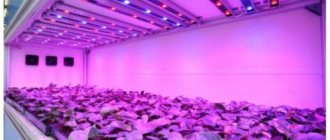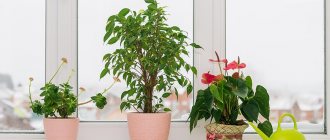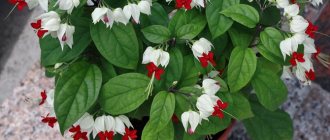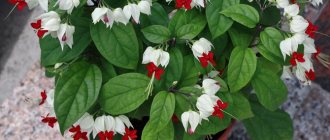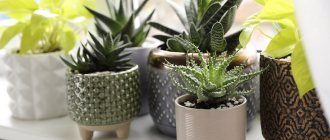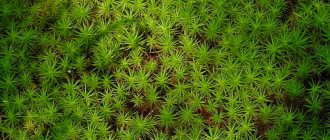Illumination is one of the most important criteria for choosing a location when placing a pot with an indoor flower or planting a seedling in open ground. Its intensity varies depending on the season of the year. For some plant species the need for it is higher, for others it is lower. Typically, the lack of natural sunlight is felt by plants in winter, as well as in December and March. If necessary, for light-loving species it can be compensated by turning on fluorescent or LED lamps.
Effect of light on plants
Light is the main source of energy necessary for the formation of hydrocarbons, fats and proteins that make up plant cells. It is absorbed by the green pigment of leaves, chlorophyll, and participates in the formation of organic substances along with water, carbon dioxide and trace elements. The combination of intensity and duration of solar insolation under natural conditions determines the change in phases of plant life - active growth, development of shoots and leaves, formation of buds, flowering, dormancy.
It is difficult for indoor plants to provide the required level of illumination for the following reasons:
- Light penetrates through a limited surface of window glass, so its intensity drops sharply at a distance from the windows.
- Window sills are often exposed to diffuse rather than direct sunlight.
- Windows on the lower floors of buildings are often obscured by nearby structures and trees.
- In rooms with dark wall surfaces and furniture colors, a significant amount of rays are absorbed by furnishings.
- When windows face north, northeast and northwest, less sunlight enters the rooms compared to south, east and west.
The upper floors of buildings and southern windows experience higher solar insolation, so flowers standing on window sills in the summer can get leaf burns and overheat.
To protect them from excess light, it is recommended to use shading of glass (sheets of paper, cloth) or place plants on shelves at some distance from the window.
It is better to place succulents on southern windows in summer. To protect the roots from overheating, you can place the pots in additional containers with sand or fine expanded clay.
How does changing the direction of light affect
Some flowers react to changes in the position of the bush in relation to the light source by dropping buds and flowers, for example, geranium, gardenia, fuchsia, and zygocactus. During the flowering period, it is not advisable to move them from place to place. In many species, shoots on the side of the light source grow denser and longer. For uniform development of decorative leafy plants, it is recommended to periodically rotate them along their axis by several degrees.
Effect of day length on flowering
The length of daylight hours has a significant impact on the flowering and fruiting of many crops. In a temperate climate zone, its shortest duration is 8 hours, maximum – 16 hours.
Based on the ratio of daylight hours and the onset of flowering, they are divided into:
- Species that require lighting for significant periods of time during the day. These include Saintpaulia, hydrangea, cineraria, gloxinia, calceolaria and some other flowers. Given sufficient daylight and good conditions, they grow and develop throughout the year. If these plants receive only natural light, they form and open buds from early spring to late summer.
- Species that bloom during short daylight hours (8 to 10 hours). These are plants such as zygocactus, poinsettia, chrysanthemum, azalea, and Kalanchoe Blossfeld.
- Indoor flowers that form buds at any length of daylight. These include evergreen begonia, rose, abutilon and some others.
- Plants that bloom when long daylight hours are replaced by short ones or vice versa. Thus, cyclamen and camellia bloom in winter, and grandiflora pelargonium blooms in spring.
Types of indoor decorative lighting
Decorative lighting for indoor plants can be different both in the nature of the impact on their perception and in the impact on the surrounding space.
There are three types of lighting for indoor plants:
- directional lighting;
- simple, or bottom lighting;
- backlighting.
Directional lighting
This type of decorative lighting involves placing an additional light source above a houseplant or group of crops to highlight the decorative qualities of the plants and create a special atmosphere.
It enhances the feeling of using carefully selected and thoughtful landscaping products. Directional light enhances the integrity of collections, distinguishes them from the general background, unites them, and for individual plants it allows them to move from the rank of background landscaping to one of the main decorations of the room. In fact, overhead decorative lighting can equate a plant to a work of art.
Simple or bottom lighting
An illuminating light frame, opposite to directional lighting, is a decorative technique that involves placing an additional light source from below, under or in front of a plant, composition. Such lighting does not so much unite plants into one group or highlight them from the background, but highlight individual details and create a play of shadows on the walls and in niches, allowing you to perceive the space and secluded atmosphere in a different way.
Backlighting
This type of lighting involves placing the light source behind the plant, usually from below. Thanks to the highlighting from behind, a feeling of a clear, catchy, contrasting silhouette is created.
Revealing lines and the play of contours, backlighting neutralizes the influence of color and allows you to create a special atmosphere that is associated with modern minimalism, revealing the value and beauty of the exotic or filling the interior with a special mysterious charm, drama or intimacy. Backlighting “works” only with solo, large plants that have expressive lines.
Directional decorative lighting of plants
Signs of too little or too much light
The ability of indoor flowers to adapt to light levels varies. There are light-loving, shade-tolerant and light-indifferent plants. Insufficient lighting has an adverse effect on plant development. Sensitivity to a decrease in its intensity is higher in light-loving species.
The lack of light is indicated by the following changes in the appearance and development of indoor flowers:
- Plants with light or variegated leaves change color due to an increase in the amount of chlorophyll to better absorb incoming light. They acquire a dark green color, sometimes become narrower and slightly elongated.
- The stems stretch in the direction of the light, but grow thin and weak. The length of the internodes increases, and at the same time their fragility increases.
- After some time, the growth of shoots and leaves stops due to deterioration of photosynthesis and lack of organic matter.
- Some plant species do not bud or bloom for a long time.
With excess light, the following changes are noticeable in the appearance of the bushes:
- The leaves turn yellow-green due to the partial destruction of chlorophyll. They can also lose turgor, drooping down, and in some cases dry out due to loss of moisture. When burned by the bright rays of the sun, the leaf plates acquire a bronze tint.
- The growth rate of stems decreases, the distance between nodes decreases, the width increases and the length of leaves decreases.
How much light do indoor plants need?
Recommended by topic
TOP 25 Most unpretentious indoor plants How to revive a home flower: drying, frozen, flooded at home 23 Houseplants that purify the indoor air
The need for light intensity differs between light-loving and shade-tolerant species. If the first grow better on eastern, western and southern window sills, the second group can also feel comfortable on a northern or partially obscured window by a tree or a neighboring house. In summer, it is advisable to shade windows facing south at midday, even for light-loving indoor flowers. Shade-tolerant plants are suitable for placement at a distance of up to 3 m from the window opening.
Light intensity is measured in lux. To determine it, a special device is used - a lux meter. On a summer day, the illumination of an east-facing window sill is approximately 2500 lux; a few meters away it drops to 500 lux. On normal winter days, the light intensity of the same window fluctuates between 500–1000 lux. If you move a little further from it, its performance decreases to values that are unable to provide even shade-loving species with sufficient light.
To compensate for the lack of natural solar radiation, artificial illumination with lamps is used.
When choosing the type of lamps, determining their optimal quantity and the distance at which it is best to place them from plants, their need for lighting depending on the time of year and day, the quality and spectral composition of the rays are taken into account.
It was experimentally discovered that at a light intensity of less than 300 and more than 3000 lux (for some of the most hardy species, above 10,000 lux), the development of flower bushes stops. Regarding the spectral component, observations have shown that the energy used in photosynthesis is absorbed from rays in the red range with a wavelength of 720 to 600 nm and orange in the range of 620–595 nm.
Also of great importance is the blue and violet spectrum of rays, necessary for the formation of protein molecules and the active growth of shoots and leaves. Their length is 490–380 nm.
Ultraviolet rays bring certain benefits. At wavelengths between 315 and 380 nm they prevent stem stretching and promote the production of a number of vitamins; at wavelengths between 280 and 315 nm they improve resistance to low temperatures.
What are decorative lighting used for?
Illumination is used in large premises, including offices, luxurious mansions, and city apartments. Regardless of whether we are talking about a private home or a large corporate building, interior designers are increasingly including large plants in the game with light, which harmonize and balance the environment, introduce natural style and improve the environment.
Decorative light creates a special atmosphere in recreation areas and rooms, changes the perception of greenhouses and winter gardens, transforms thematic collections, complementing the beauty of plants, enhancing the impression.
In small rooms, decorative lighting is most often not used (it can lead to an undesirable change in the perception of space). But if the task is to create a special atmosphere or expand the space, then you can not only use lower or upper lighting along the contours of the rooms, but also “highlight” indoor plants from the general background.
Living rooms, halls, corridors, passages, lobbies, even in not very large apartments, can be made special by simply highlighting large accent plants.
For small rooms - small decorative lighting
How to choose a lamp
When choosing a lamp for supplementary illumination of plants, the preferences of individual species and varieties and the stage of development are taken into account. For example, for growing seedlings it is better to use LED lamps with a red and blue spectrum of rays. This will ensure uniform seed germination, proper development of seedlings, and the formation of healthy shoots and leaves. In principle, the versatility of LED lamps allows them to be used for any type of indoor and greenhouse plants. You just need to adjust the color and intensity of the lighting in each specific case.
For a free-standing bush or a small container with seedlings, it is enough to use a lamp with an E27 base, which is designed to be screwed into regular sockets.
A linear lamp will provide light to the entire surface of a window sill or flower stand. Large light panels are suitable for installation in a greenhouse or winter garden, covering a significant part of the space.
Fluorescent fluorescent lamps are suitable for additional illumination of plants in winter and during the dormant period. Sodium lamps with red radiation ensure abundant flowering and fruiting of greenhouse crops. For example, they will allow tulips to bloom almost simultaneously by March 8th. The absence of the blue spectrum in the glow of sodium lamps stimulates the high growth of stems of roses grown for cutting.
Guseva Ulyana
Ask a Question
Question to the expert
How to calculate the required power of a phytolamp to illuminate 1 m2 of area?
For plants located on or near a windowsill, 40 W per 1 m2 is sufficient. For the most light-loving species and when grown at a considerable distance from the window, a lamp with a power of 60 W is required to illuminate the same amount of area.
What artificial light source should you use?
Literally 10 years ago there was absolutely nothing to choose from. The illumination for the flowers was created as best they could - they used ordinary incandescent light bulbs. There was an undoubted advantage from them - they provided a spectrum that was very similar to direct sunlight. Several low-power bulbs could significantly improve the condition of flowering and ornamental plants, and they also provided a fairly strong flow of heat, which was so necessary for newly emerged seedlings. Such good qualities of incandescent lamps were supported by one significant disadvantage - they were completely uneconomical, their efficiency was so low that lighting plants of impressive volumes cost owners a pretty penny.
Lighting a plant with an incandescent lamp
More recently, they have been replaced by fluorescent lamps for plants. They were presented in all sorts of forms and powers, the efficiency increased significantly - the lamps began to consume electricity much more economically, giving off more light and less heat. And even with the advent of LED analogues, today it is fluorescent lamps that are most popular. Their properties have already been studied, methods for calculating lighting have been developed for certain conditions and types of indoor plants, they are inexpensive and provide an excellent spectrum for the growth and development of collections of flowers and seedlings in indoor conditions.
Lighting seedlings with long fluorescent lamps
Correct lamp installation
When placing the lamp, it is necessary to take into account that the light intensity decreases in proportion to the distance from the plant: if the distance from the top point of the bush is increased by 2 times, its illumination will decrease by 4 times. To prevent the rays from scattering to the sides, the lamps are equipped with reflectors. It is advisable that the surface of the walls is also light or covered with foil (for example, in a greenhouse) to reduce light loss.
It is recommended to place the phytolamp as close as possible to the plant, but not less than 10–15 cm from it. These numbers are relevant when growing seedlings.
For bushes of medium height, the lamps are placed 20–30 cm above their surface. When the lamp is removed more than 50 cm, its effectiveness decreases significantly. As plant growth gradually increases, it becomes necessary to raise the lighting fixture higher from time to time. Also, the distance between the flower and the lamp is adjusted based on the power of the lamp and the needs of the species being grown.
Decorative lighting in interior landscaping
Techniques and means for organizing interior lighting have developed very successfully in recent years. Spot, strip and background, illuminating and classic, color and dramatic, luminaires and lamps that play with the perception of space allow you to control both the functional side and the decorative role of light in the decor of rooms.
The expansion of the range of modern methods and ways of using light could not but affect one of the most important elements of interior design - landscaping. After all, you can present not only furniture and decor, but also your favorite plants in a favorable light.
Decorative lighting for indoor plants refers to all decorative techniques aimed at representing the special role of a plant in the interior with the help of an additional light source located nearby.
Decorative lighting performs two main functions:
- creates an atmosphere, sets the style and special mood in the room;
- reveals, emphasizes or enhances the beauty of the plant and its most decorative features - leaves, flowers, inflorescences, shoot lines.
How to tell if your plants are getting enough light
Recommended by topic
Delphinium Carnation Catharanthus
The lack of lighting can be inferred from the appearance of the bushes. To better use all incoming rays, the surface of the leaves turns in the direction of the light source. Increased production of chlorophyll begins in the cells, due to which light-colored or variegated leaf blades acquire a rich dark green hue. New leaves at the top of the stem are pale and slightly colored.
The shoots lengthen, trying to be closer to the light. At the same time, they become thin and brittle, with unnaturally elongated internodes. The lower leaves, which are most acutely experiencing a lack of light, begin to turn yellow and gradually fall off, because of this the base of the stem is exposed. The plant stops forming buds, flowers appear less frequently, are small and faded, or flowering is completely absent.
What kind of lighting should the plants have?
Plants need additional lighting mainly during the period of decreasing daylight hours. They start to miss the sun's rays already in October. And they will have to remain in such light time pressure until mid-spring. The deficiency is compensated by lighting the plantings with special lamps for plants. Their range today is very diverse. Lamps can be found in pendant, wall-mounted, tabletop and tripod-mounted designs.
A lamp for plants can be purchased in any configuration
When choosing a lamp type, pay attention to the number of operating hours. Please note that you will have to turn on the device not from time to time, but constantly. Pulse lighting is harmful to plants. They lose their usual biorhythms and begin to get sick. The most important rays for house flowers are those in the violet-blue and red-orange range. The former are responsible for vegetative processes, the latter for growth. When looking for a lamp, you need to look at those models where the red spectrum plays a leading role.
If you need to illuminate a large area, then it would be better to purchase ceiling-type phytolamps.
Ceiling lighting is suitable for large areas
In niches for plants with lighting, the question is somewhat simpler. The lamp in them can be either a vertical type or a wall-mounted one. When placing lighting lamps for plants, you need to make sure that the light fluxes coming from them do not interfere with the penetration of daylight.
Lighting for plants in niches
Another trick. Considering that plants are intuitively drawn to a light source, in a greenhouse or greenhouse, phytolamps should be installed on both sides of the beds or rows.
What light is best for growth?
The growth of shoots and the appearance of new leaves occurs normally in the red and blue spectrum of radiation. Active photosynthesis requires light wavelengths from 300 to 720 nm. The blue spectrum promotes the formation of proteins and carbons. Ultraviolet rays prevent the elongation of stems and increase the synthesis of vitamins. The red and orange spectrum improves flowering and fruiting, and seed germination.
Lighting in winter
In the winter months, flowers should be moved to the brightest window sills, moved from the north side of the house to the southern and eastern windows.
For the most light-loving species, it is advisable to provide additional lighting.
For these purposes, LED lamps are used. They are economical and provide the entire required radiation spectrum. Minimal heat generation allows these lamps to be placed at a short distance from the plant.
Also, for illuminating seedlings and light-loving species of compact size, energy-saving lamps Foton, Elektrox, TNeon fluorescent lamps are suitable, for bushes in the flowering and fruiting stages - sodium HPS Grolux, Green Power, Prima Klima, etc. For effective operation of these devices, reflectors and ballasts should be used devices.
Question to the expert
Please tell me how many hours a day should indoor plants be illuminated?
It is desirable that the total duration of illumination be 12–14 hours. For example, with an 8-hour daylight hours, the flowers are illuminated for 4–5 hours. If the intensity of solar radiation is insufficient in cloudy weather, in a north-facing or shaded window you can turn on the lamp during the day. When germinating seeds, when the entrances appear, the light can not be turned off for the first 3 days, then gradually over several days the duration of additional lighting is increased to 14 hours.
Houseplants that require a lot of light
The most light-loving species include myrtle, pineapple, roses, Kalanchoe, spurge, citrus fruits, bocarneya, bougainvillea, southern cordyline, hibiscus, pittosporum, succulents, yucca, acacia, oleander. They require high lighting intensity - from 4000 lux.
At a short distance (up to 2 m) from a sunny window, avocado, banana, gardenia, hibiscus, lily, ficus, coconut, coffee tree, begonia, zamioculcas, dracaena, passionflower, cyclamen, primrose, caladium, gloxinia, sundew, zantedeschia feel comfortable , saintpaulia, gardenia, araucaria, cyperus, abutilone.
Indoor plants that don't require a lot of light
From 1000 to 3000 lux of light is sufficient for ferns, gesneria, bromeliad, billbergia, fittonia, scindapsus, shieldweed, davallia, aspidistra, fatsia, ivy (without variegated leaf color), bellflower, Venus flytrap, dwarf ficus, pellea.
Diffused light with an intensity of 3000 to 4000 lux is needed for aglaonema, tillandsia, fuchsia, begonia, nepenthes, variegated ivy, streptocarpus, mimosa, clivia, cirpus, asparagus, tradescantia, balsam, philodendron, syngonium, tillandsia, clusia, rhododendron, antur iyumu.
The correct placement of plants on windows or at some distance from them contributes to a beautiful appearance and active development of bushes. During the dormant period, indoor flowers should be provided with sufficient lighting, slightly reducing the air temperature in the room. Various types of lamps with red and blue wavelengths are suitable for additional lighting. Additional lighting of seedlings will allow you to obtain strong and well-developed seedlings.
